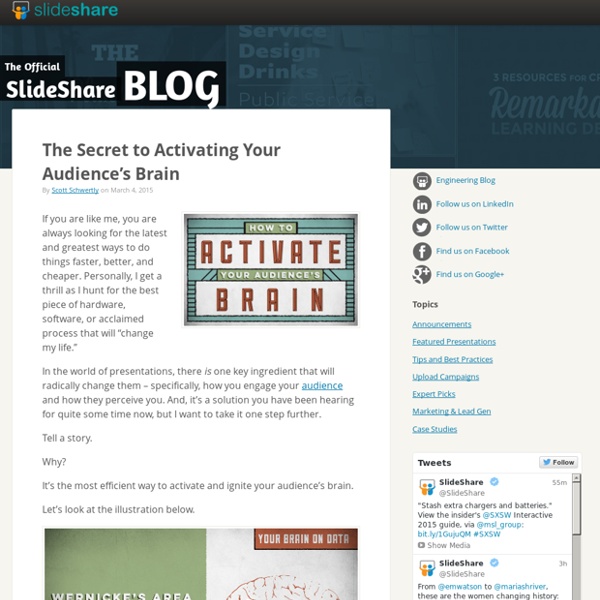The Secret to Activating Your Audience’s Brain
If you are like me, you are always looking for the latest and greatest ways to do things faster, better, and cheaper. Personally, I get a thrill as I hunt for the best piece of hardware, software, or acclaimed process that will “change my life.” In the world of presentations, there is one key ingredient that will radically change them – specifically, how you engage your audience and how they perceive you. Tell a story. Why? It’s the most efficient way to activate and ignite your audience’s brain. Let’s look at the illustration below. When you share facts and stats with your audience: 1. 2. Hence, only two parts of your audiences’ brain will ignite when reacting to data. But, what if you tell a story instead? A story doesn’t spark agreement or disagreement but rather participation. If you want to see all of this in more amazing detail, here’s an entire infographic my team created a few days ago. Author Bio
Bleep : une messagerie en mode privé
Si dans le cadre de votre travail, vous avez besoin de passer une conversation confidentielle sur Internet (loin de tout espionnage industriel), oubliez Skype. Il existe des messageries bien plus sûres, dont l’objectif est de garantir la confidentialité des communications. En juillet, les développeurs de BitTorrent, le célèbre logiciel d’échange de fichiers peer-too-peer (P2P) ont dévoilé une messagerie décentralisée et sécurisée. Ce logiciel, Bleep, se veut sécurisé grâce à son architecture, qui repose sur le P2P : pas de centralisation, les données partent de l’ordinateur de l’utilisateur jusqu’à celui de son correspondant, sans passer par un serveur tiers - contrairement aux messageries classiques, qui stockent, même temporairement, les données dans leurs machines. Les communications via Bleep sont intégralement chiffrées. Pour l’instant, Bleep est disponible sur invitation, en version “Alpha” - sous Windows 7 et 8 (mais le logiciel s’étendra vite à d’autres systèmes d’exploitation).
The Case For Visual Literacy
The way we’ve learned to communicate is wrong. Denizens of business, deep in the world of operations reviews, presentations and pitches, are communicating past each other, drowning in a sea of PowerPoint. It seems the general rule of corporate culture is to put that on a deck, or put some slides together. Many of you reading this will have lived through that ritual. We cannot speak to each other without consulting PowerPoint, talking in acronyms and using big words to confabulate our ideas. You have a choice. The choice behind door number one is to learn this arcane language of leverage and synergy, the buzzwords of hyper-growth and ecosystem, the acronyms of EBITDA and ARPU, and reskill yourself with PowerPoint. Behind door number two is a return to your roots. Door number two is a journey of unlearning the acquired jargon from your system and cleanse your palette of corporate BS. To understand why this is relevant now, more than ever, we must go back. Two million years.
Bon et puis ça: c'est sur mon site officiel... - BERNARD WERBER OFFICIEL
5 Powerful Ways to Open a Presentation
We’ve all been there before: staring at the glow of your blank computer screen with no idea on how to open or start your talk. For starters, you should never be staring at PowerPoint with no clear objective (that’s a conversation for another day), but let’s be honest, we’ve all struggled with the best ways to open a presentation. It’s time to get unstuck. Here are 5 powerful ways to open a presentation: 1. Most people won’t be able to pull this off very easily, but if you are feeling like a rockstar during your next presentation, opt for silence. 2. I have two simple statements for you: -Prospective (looking to the future): “30 Years from now, your job won’t exist.” -Retrospective (looking to the past): “In 1970, Japan owned 9% of the market. The reality is that looking into the future or past always sparks engagement since that’s where our hearts live. 3. The easiest way to open a talk is simply to quote someone. 4. I don’t know about you, but I love Snapple. 5. Related Posts
Related:
Related:



